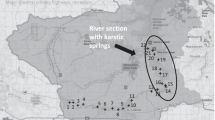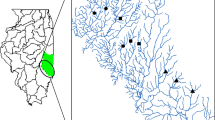Abstract
We explored land use, fish assemblage structure, and stream habitat associations in 20 catchments in Opequon Creek watershed, West Virginia. The purpose was to determine the relative importance of urban and agriculture land use on stream biotic integrity, and to evaluate the spatial scale (i.e., whole-catchment vs riparian buffer) at which land use effects were most pronounced. We found that index of biological integrity (IBI) scores were strongly associated with extent of urban land use in individual catchments. Sites that received ratings of poor or very poor based on IBI scores had > 7% of urban land use in their respective catchments. Habitat correlations suggested that urban land use disrupted flow regime, reduced water quality, and altered stream channels. In contrast, we found no meaningful relationship between agricultural land use and IBI at either whole-catchment or riparian scales despite strong correlations between percent agriculture and several important stream habitat measures, including nitrate concentrations, proportion of fine sediments in riffles, and the abundance of fish cover. We also found that variation in gradient (channel slope) influenced responses of fish assemblages to land use. Urban land use was more disruptive to biological integrity in catchments with steeper channel slopes. Based on comparisons of our results in the topographically diverse Opequon Creek watershed with results from watersheds in flatter terrains, we hypothesize that the potential for riparian forests to mitigate effects of deleterious land uses in upland portions of the watershed is inversely related to gradient.
Similar content being viewed by others
References
Angermeier P.L. and Smogor R.A. 1995. Estimating number of species and relative abundances of stream-fish communities: effects of sampling effort and discontinuous spatial distributions. Canadian Journal of Fisheries and Aquatic Sciences 52: 936–949.
Barton D.R., Taylor W.D. and Biette R.M. 1985. Dimensions of riparian buffer strips required to maintain trout habitat in southern Ontario streams. North American Journal of Fisheries Management 5: 364–378.
Bisson P.A., Bilby R.E., Bryant M.D., Dolloff C.A., Grette G.B., House R.A. et al. 1987. Large woody debris in forested streams of the Pacific northwest: past, present, and future. In: Salo E.O. and Cundy T.W. (eds), Streamside Management: Forestry and Fishery Interactions. Contribution no. 57. Institute of Forest Resources, University of Washington, Seattle, Washington, USA, pp. 143–190.
Browne F.X. 1981. Non-point sources. Journal of the Water Pollution and Control Federation 53: 901–908.
Correll D.L., Jordan T.E. and Weller D.E. 1992. Nutrient flux in a landscape: Effects of coastal land use and terrestrial community mosaic on nutrient transport to coastal waters. Estuaries 15: 431–442.
Cummins K.W. 1962. An evaluation of some techniques for the collection and analysis of benthic samples with special emphasis on lotic waters. American Midland Naturalist 67: 477–504.
Cummins K.W. 1992. Catchment characteristics and river ecosystems. In: Boon P.J., Calow P. and Petts G.E. (eds), River Conservation and Management. John Wiley and Sons, Chichester, UK, pp. 125–135.
Davies P.E. and Nelson M. 1994. Relationship between riparian buffer widths and the effects of logging on stream habitat, invertebrate community composition, and fish abundance. Australian Journal of Marine and Freshwater Research 45: 1289–1305.
Frissell C.A., Liss W.J., Warren C.E. and Hurley M.D. 1986. A hierarchical framework for stream habitat classification: Viewing streams in a watershed context. Environmental Management 10: 199–214.
Gorman O.T. and Karr J.R. 1978. Habitat structure and stream fish communities. Ecology 59: 507–515.
Gregory S.V., Swanson F.J., McKee W.A. and Cummins K.W. 1991. An ecosystem perspective of riparian zones. BioScience 41: 540–551.
Gregory K.J. 1992. Vegetation and river channel process interactions. In: Boon P.J., Calow P. and Petts G.E. (eds), River conservation and management. John Wiley and Sons, Chichester, UK, pp. 255–270.
Hawkins C.P., Kershner J.L., Bisson P.A., Bryant M.D., Decker L.M., Gregory S.V. et al. 1993. A hierarchical approach to classifying stream habitat features. Fisheries 18: 3–12.
Hynes H.B.N. 1975. The stream and its valley. Proceedings of the International Association of Theoretical and Applied Limnology 19: 1–15.
Imhof J.G., Planck R.J., Johnson F.M. and Halyk L.C. 1991. Watershed urbanization and managing stream habitat for fish. In: Transactions of the 56th North American Wildlife and Natural Resources Conference. Edmonton, Alberta, Canada, pp. 269–285.
Judy R.D. Jr, Seeley P.N., Murray T.M., Svirsky S.C., Whitworth M.R. and Ischinger L.S. 1984. 1982 Fisheries Survey. Technical report: initial findings. FWS/OBS-84/06. U.S. Fish and Wildlife Service, Washington, DC, USA, 140 pp.
Karr J.R. 1991. Biological integrity: a long neglected aspect of water resource management. Ecological Applications 1: 66–84.
Klauda R., Kazyak P., Stranko S., Southerland M., Roth N. and Chaillou J. 1998. Maryland biological stream survey: A state agency program to assess the impact of anthropogenic stresses on stream habitat quality and biota. Environmental Monitoring and Assessment 51: 299–316.
Lammert M. and Allan J.D. 1999. Assessing biotic integrity of streams: effects of scale in measuring the influence of land use/cover and habitat structure on fish and macroinvertebrates. Environmental Management 23: 257–270.
Leopold L.B. 1968. Hydrology for urban land planning: a guide-book on the hydrologic effects of urban land use. U.S. Geological Survey Circular 554, Washington, DC, USA, 18 pp.
Lydy M.J., Strong A.J. and Simon T.P. 2000. Development of an Index of Biotic Integrity for the Little Arkansas River Basin, Kansas. Archives of Environmental Contamination and Toxicology 39: 523–530.
Lyons J. 1992. The length of stream to sample with a towed electrofishing unit when fish species richness is estimated. North American Journal of Fisheries Management 12: 198–203.
McCormick F.H., Hughes R.M., Haufmann P.R., Herlihy A.T., Peck D.V. and Stoddard J.L. 2001. Development of an index of biotic integrity for the Mid-Atlantic Highlands Region. Transactions of the American Fisheries Society 130: 857–877.
McDonnell M.J. and Pickett S.T.A. 1990. Ecosystem structure and function along urban-rural gradients: an unexploited opportunity for ecology. Ecology 71: 1232–1237.
Naiman R.J. and Décamps H. (eds) 1990. The Ecology and Management of Aquatic-Terrestrial Ecotones. Parthenon Publishing Group, Carnforth, UK.
Naiman R.J., Lonzarich D.G., Beechie T.J. and Ralph S.C. 1992. General principles of classification and the assessment of conservation potential in rivers. In: Boon P.J., Calow P. and Petts G.E. (eds), River Conservation and Management. John Wiley and Sons, Chichester, UK, pp. 93–123.
Naiman R.J., Décamps H. and Pollock M. 1993. The role of riparian corridors in maintaining regional biodiversity. Ecological Applications 3: 209–212.
Osborne L.L. and Wiley M.J. 1988. Empirical relationships between land use/cover and stream water quality in an agricultural watershed. Journal of Environmental Management 26: 9–27.
Perterjohn W.T. and Correll D.L. 1984. Nutrient dynamics in an agricultural watershed: observations on the role of a riparian forest. Ecology 65: 1466–1475.
Poff N.L. and Ward J.V. 1990. Physical habitat template of lotic systems: Recovery in the context of historical pattern of spatiotemporal heterogeneity. Environmental Management 14: 629–645.
Rabeni C.F. and Smale M.A. 1995. Effects of siltation on stream fishes and the potential mitigating role of the buffering riparian zone. Hydrobiologia 303: 211–219.
Richards C., Johnson L.B. and Host G.E. 1996. Landscape-scale influences on stream habitats and biota. Canadian Journal of Fisheries and Aquatic Sciences 53: 295–311.
Risser P.G. 1990. The Ecological Importance of Land-Water Ecotones. In: Naiman R.J. and Décamps H. (eds), The ecology and management of aquatic-terrestrial ecotones. The Parthenon Publishing Group Inc., Carnforth, UK, pp. 7–22.
Rosgen D.L. 1994. A classification of natural rivers. Catena 22: 169–199.
Roth N.E., Southerland M.T., Chaillou J.C., Kazyak P.F. and Stranko S.A. 2000. Refinement and validation of a fish index of biotic integrity for Maryland streams. Chesapeake Bay and Watershed Programs, Monitoring and Non-tidal Assessment. CBWP-MANTA-EA-00. Versar Inc., Columbia, Maryland, USA.
Roth N., Southerland M., Chaillou J., Klauda R., Dazyak P., Stranko S. et al. 1998. Maryland biological stream survey: Development of a fish index of biotic integrity. Environmental Monitoring and Assessment 51: 89–106.
Roth N.E., Allan J.D. and Erickson D.L. 1996. Landscape influences on stream biotic integrity assessed at multiple spatial scales. Landscape Ecology 11: 141–156.
Schiemer F. and Zalewski M. 1992. The importance of riparian ecotones for diversity and productivity of riverine fish communities. Netherlands Journal of Zoology 42: 323–335.
Schleiger S.L. 2000. Use of an Index of Biotic Integrity to detect effects of land uses on stream fish communities in west-central Georgia. Transactions of the American Fisheries Society 129: 1118–1133.
Schlosser I.J. 1982. Fish community structure and function along two habitat gradients in a headwater stream. Ecological Monographs 52: 395–414.
Schlosser I.J. 1991. Stream fish ecology: a landscape perspective. BioScience 41: 704–712.
Sheldon A.L. and Meffe G.K. 1995. Path analysis of collective properties and habitat relationships of fish assemblages in coastal plain streams. Canadian Journal of Fisheries and Aquatic Sciences 52: 23–33.
Greenberg A.E., Eaton A.D. and Cleseri L.S. (eds) 1992. Standard Methods for the Examination of Water and Wastewater. American Public Health Association, Washington, DC, USA, Published jointly by the American Public Health Association, American Water Works Association, and Water Environment Federation.
Stauffer J.C., Goldstein R.M. and Newman R.M. 2000. Relationship of wooded riparian zones and runoff potential to fish community composition in agricultural stream. Canadian Journal of Fisheries and Aquatic Sciences 57: 307–316.
Steedman R.J. 1988. Modification and assessment of an index of biotic integrity to quantify stream quality in southern Ontario. Canadian Journal of Fisheries and Aquatic Sciences 45: 492–501.
Sweeney B.W. 1992. Streamside forests and the physical, chemical, and trophic characteristics of Piedmont streams in eastern North America. Water Science Technology 26: 2653–2673.
United States Environmental Protection Agency 2000. Water quality conditions in the United States: A profile from the 1998 National water quality inventory report to congress. EPA841-F-00-006. US EPA, Washington, DC, USA.
Vannote R.L., Minshall G.W., Cummins K.W., Sedell J.R. and Cushing C.E. 1980. The river continuum concept. Canadian Journal of Fisheries and Aquatic Sciences 37: 130–137.
Vogelmann J., Sohl T. and Howard S. 1998a. Regional Characterization of Land Cover Using Multiple Sources of Data. Photogrammetric Engineering and remote sensing 64: 45–57.
Vogelmann J.E., Sohl T.L., Campbell P.V. and Shaw D.M. 1998b. Regional land cover characterization using Landsat thematic mapper data and ancillary data sources. Environmental Monitoring and Assessment 51: 415–428.
Wang L., Lyons J., Kanehl P., Bannerman R. and Emmons E. 2000. Watershed urbanization and changes in fish communities in southeastern Wisconsin streams. Journal of the American Water Resources Association 36: 1173–1175.
Wang L.W., Lyons J., Kanehl P. and Gatti R. 1997. Influences of watershed land use on habitat quality and biotic integrity in Wisconsin streams. Fisheries 22: 6–12.
Wallace J.B., Eggert S.L., Meyer J.L. and Webster J.R. 1999. Effects of resource limitation on a detrital-based ecosystem. Ecological Monographs 69: 409–442.
Wissmar R.C. and Swanson F.J. 1990. Landscape disturbances and lotic ecotones. In: Naiman R.J. and Décamps H. (eds), The Ecology and Management of Aquatic-Terrestrial Ecotones. Parthenon Publishing Group, Carnforth, UK, pp. 65–89.
Wootton R.J. 1990. Ecology of Teleost Fishes. Chapman and Hall Publishers, London, UK.
Zampella R.A. 1994. Characterization of surface water quality along a watershed disturbance gradient. Water Resources Bulletin 30: 605–611.
Author information
Authors and Affiliations
Rights and permissions
About this article
Cite this article
Snyder, C., Young, J., Villella, R. et al. Influences of upland and riparian land use patterns on stream biotic integrity. Landscape Ecol 18, 647–664 (2003). https://doi.org/10.1023/B:LAND.0000004178.41511.da
Issue Date:
DOI: https://doi.org/10.1023/B:LAND.0000004178.41511.da




